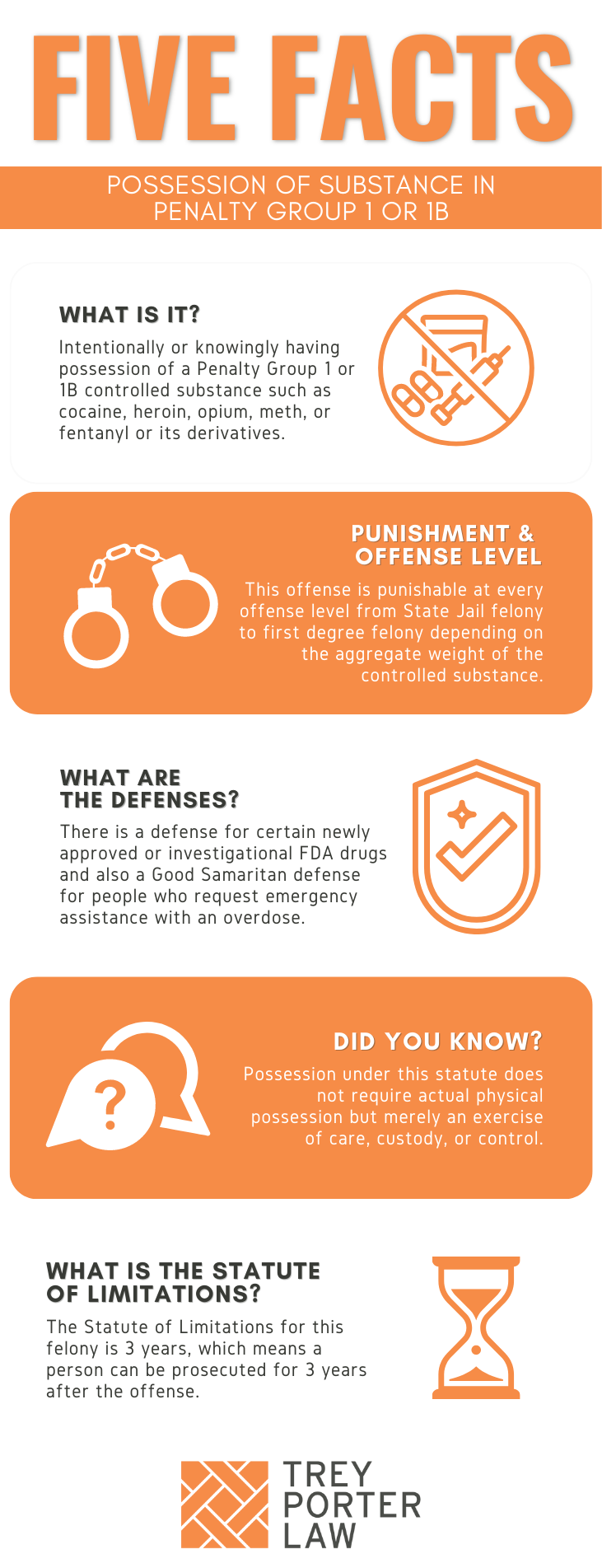WHAT IS POSSESSION OF SUBSTANCE IN PENALTY GROUP 1 OR 1-B IN TEXAS?
The Texas law against possession of substance in Penalty Group 1 or 1-B prohibits intentionally or knowingly having care, custody, control, or management of a controlled substance listed in Penalty Group 1 or 1-B.

- What is a controlled substance? Texas Health and Safety Code Section 481.002 defines a “controlled substance” as a substance, including a drug, listed in Schedules I through V or Penalty Group 1, 1-A, 1-B, 2, 2-A, 3, or 4. The term includes the aggregate weight of any mixture, solution, or other substance containing a controlled substance, but does not include “hemp” as defined by Texas Agriculture Code Section 121.001, or the tetrahydrocannabinols in hemp.
- What is the difference between Schedules I, II, III, IV, and V and the penalty groups of controlled substances? Controlled substances are divided into five “schedules” based on potential for abuse or addiction, which dictate the rules medical professionals must follow in prescribing medications listed in each schedule. Schedule I, for example, are the most addictive substances, and may generally not be prescribed. Substances in Schedule I are also typically in Penalty Group 1, and are considered illegal under most circumstances.Controlled substances are divided into “penalty groups” for determining criminal classification and penalties.
- What controlled substances are in Penalty Group 1 in Texas? Texas Health and Safety Code Section 481.102 lists the following controlled substances in Penalty Group 1:
-
- the following opiates, including their isomers, esters, ethers, salts, and salts of isomers, esters, and ethers, unless specifically excepted, if the existence of these isomers, esters, ethers, and salts is possible within the specific chemical designation:
- Alfentanil;
- Allylprodine;
- Alphacetylmethadol;
- Benzethidine;
- Betaprodine;
- Clonitazene;
- Diampromide;
- Diethylthiambutene;
- Difenoxin not listed in Penalty Group 3 or 4;
- Dimenoxadol;
- Dimethylthiambutene;
- Dioxaphetyl butyrate;
- Dipipanone;
- Ethylmethylthiambutene;
- Etonitazene;
- Etoxeridine;
- Furethidine;
- Hydroxypethidine;
- Ketobemidone;
- Levophenacylmorphan;
- Meprodine;
- Methadol;
- Moramide;
- Morpheridine;
- Noracymethadol;
- Norlevorphanol;
- Normethadone;
- Norpipanone;
- Phenadoxone;
- Phenampromide;
- Phenomorphan;
- Phenoperidine;
- Piritramide;
- Proheptazine;
- Properidine;
- Propiram;
- Sufentanil;
- Tilidine; and
- Trimeperidine;
- the following opium derivatives, their salts, isomers, and salts of isomers, unless specifically excepted, if the existence of these salts, isomers, and salts of isomers is possible within the specific chemical designation:
- Acetorphine;
- Acetyldihydrocodeine;
- Benzylmorphine;
- Codeine methylbromide;
- Codeine-N-Oxide;
- Cyprenorphine;
- Desomorphine;
- Dihydromorphine;
- Drotebanol;
- Etorphine, except hydrochloride salt;
- Heroin;
- Hydromorphinol;
- Methyldesorphine;
- Methyldihydromorphine;
- Monoacetylmorphine;
- Morphine methylbromide;
- Morphine methylsulfonate;
- Morphine-N-Oxide;
- Myrophine;
- Nicocodeine;
- Nicomorphine;
- Normorphine;
- Pholcodine; and
- Thebacon;
- Opium and opiate not listed in Penalty Group 3 or 4, and a salt, compound, derivative, or preparation of opium or opiate, other than thebaine derived butorphanol, nalmefene and its salts, naloxone and its salts, and naltrexone and its salts, but including:
- Codeine not listed in Penalty Group 3 or 4;
- Dihydroetorphine;
- Ethylmorphine not listed in Penalty Group 3 or 4;
- Granulated opium;
- Hydrocodone not listed in Penalty Group 3;
- Hydromorphone;
- Metopon;
- Morphine not listed in Penalty Group 3;
- Opium extracts;
- Opium fluid extracts;
- Oripavine;
- Oxycodone;
- Oxymorphone;
- Powdered opium;
- Raw opium;
- Thebaine; and
- Tincture of opium;
- a salt, compound, isomer, derivative, or preparation of a substance that is chemically equivalent or identical to a substance described above, other than the isoquinoline alkaloids of opium;
- Opium poppy and poppy straw;
- Cocaine, including:
- its salts, its optical, position, and geometric isomers, and the salts of those isomers;
- coca leaves and a salt, compound, derivative, or preparation of coca leaves; and
- a salt, compound, derivative, or preparation of a salt, compound, or derivative that is chemically equivalent or identical to cocaine, other than decocainized coca leaves or extractions of coca leaves that do not contain cocaine or ecgonine; and
- concentrate of poppy straw, meaning the crude extract of poppy straw in liquid, solid, or powder form that contains the phenanthrine alkaloids of the opium poppy;
- the following opiates, including their isomers, esters, ethers, salts, and salts of isomers, if the existence of these isomers, esters, ethers, and salts is possible within the specific chemical designation:
- Acetyl-alpha-methylfentanyl (N-[1-(1-methyl-2- phenethyl)-4-piperidinyl]-N-phenylacetamide);
- Alpha-methylthiofentanyl (N-[1-methyl-2-(2- thienyl)ethyl-4-piperidinyl]-N-phenylpropanamide);
- Alphaprodine;
- Anileridine;
- Beta-hydroxyfentanyl (N-[1-(2-hydroxy-2- phenethyl)-4-piperidinyl] -N-phenylpropanamide);
- Beta-hydroxy-3-methylfentanyl;
- Bezitramide;
- Carfentanil;
- Dihydrocodeine not listed in Penalty Group 3 or 4;
- Diphenoxylate not listed in Penalty Group 3 or 4;
- Isomethadone;
- Levomethorphan;
- Levorphanol;
- Metazocine;
- Methadone;
- Methadone-Intermediate, 4-cyano-2-dimethylamino- 4, 4-diphenyl butane;
- 3-methylfentanyl(N-[3-methyl-1-(2-phenylethyl)- 4-piperidyl]-N-phenylpropanamide);
- 3-methylthiofentanyl(N-[3-methyl-1-(2-thienyl) ethyl-4-piperidinyl]-N-phenylpropanamide);
- Moramide-Intermediate, 2-methyl-3-morpholino-1, 1-diphenyl-propane-carboxylic acid;
- Para-fluorofentanyl(N-(4-fluorophenyl)-N-1-(2- phenylethyl)-4-piperidinylpropanamide);
- PEPAP (1-(2-phenethyl)-4-phenyl-4- acetoxypiperidine);
- Pethidine (Meperidine);
- Pethidine-Intermediate-A, 4-cyano-1-methyl-4- phenylpiperidine;
- Pethidine-Intermediate-B, ethyl-4- phenylpiperidine-4 carboxylate;
- Pethidine-Intermediate-C, 1-methyl-4- phenylpiperidine-4-carboxylic acid;
- Phenazocine;
- Piminodine;
- Racemethorphan;
- Racemorphan;
- Remifentanil; and
- Thiofentanyl(N-phenyl-N-[1-(2-thienyl)ethyl-4- piperidinyl]-propanamide);
- Flunitrazepam (trade or other name: Rohypnol);
- Methamphetamine, including its salts, optical isomers, and salts of optical isomers;
- Phenylacetone and methylamine, if possessed together with intent to manufacture methamphetamine;
- Phencyclidine, including its salts;
- Gamma hydroxybutyric acid (some trade or other names: gamma hydroxybutyrate, GHB), including its salts;
- Ketamine;
- Phenazepam;
- U-47700;
- AH-7921;
- ADB-FUBINACA;
- AMB-FUBINACA; and
- MDMB-CHMICA.
- the following opiates, including their isomers, esters, ethers, salts, and salts of isomers, esters, and ethers, unless specifically excepted, if the existence of these isomers, esters, ethers, and salts is possible within the specific chemical designation:
- What controlled substances are in Penalty Group 1-B in Texas? According to Texas Health and Safety Code Section 481.1022, Penalty Group 1-B consists of fentanyl, alpha-methylfentanyl, and any other derivative of fentanyl.
WHAT IS THE POSSESSION OF SUBSTANCE IN PENALTY GROUP 1 OR 1-B LAW IN TEXAS?
Tex. Health & Safety Code § 481.115. POSSESSION OF SUBSTANCE IN PENALTY GROUP 1 OR 1-B.
(a) Except as authorized by this chapter, a person commits an offense if the person knowingly or intentionally possesses a controlled substance listed in Penalty Group 1 or 1-B, unless the person obtained the substance directly from or under a valid prescription or order of a practitioner acting in the course of professional practice.
(b) An offense under Subsection (a) is a state jail felony if the amount of the controlled substance possessed is, by aggregate weight, including adulterants or dilutants, less than one gram.
(c) An offense under Subsection (a) is a felony of the third degree if the amount of the controlled substance possessed is, by aggregate weight, including adulterants or dilutants, one gram or more but less than four grams.
(d) An offense under Subsection (a) is a felony of the second degree if the amount of the controlled substance possessed is, by aggregate weight, including adulterants or dilutants, four grams or more but less than 200 grams.
(e) An offense under Subsection (a) is a felony of the first degree if the amount of the controlled substance possessed is, by aggregate weight, including adulterants or dilutants, 200 grams or more but less than 400 grams.
(f) An offense under Subsection (a) is punishable by imprisonment in the Texas Department of Criminal Justice for life or for a term of not more than 99 years or less than 10 years, and a fine not to exceed $100,000, if the amount of the controlled substance possessed is, by aggregate weight, including adulterants or dilutants, 400 grams or more.
(g) It is a defense to prosecution for an offense punishable under Subsection (b) that the actor:
(1) was the first person to request emergency medical assistance in response to the possible overdose of another person and:
(A) made the request for medical assistance during an ongoing medical emergency;
(B) remained on the scene until the medical assistance arrived; and
(C) cooperated with medical assistance and law enforcement personnel; or
(2) was the victim of a possible overdose for which emergency medical assistance was requested, by the actor or by another person, during an ongoing medical emergency.
(h) The defense to prosecution provided by Subsection (g) is not available if:
(1) at the time the request for emergency medical assistance was made:
(A) a peace officer was in the process of arresting the actor or executing a search warrant describing the actor or the place from which the request for medical assistance was made; or
(B) the actor is committing another offense, other than an offense punishable under Section 481.1151(b)(1), 481.116(b), 481.1161(b)(1) or (2), 481.117(b), 481.118(b), or 481.121(b)(1) or (2), or an offense under Section 481.119(b), 481.125(a), 483.041(a), or 485.031(a);
(2) the actor has been previously convicted of or placed on deferred adjudication community supervision for an offense under this chapter or Chapter 483 or 485;
(3) the actor was acquitted in a previous proceeding in which the actor successfully established the defense under that subsection or Section 481.1151(c), 481.116(f), 481.1161(c), 481.117(f), 481.118(f), 481.119(c), 481.121(c), 481.125(g), 483.041(e), or 485.031(c); or
(4) at any time during the 18-month period preceding the date of the commission of the instant offense, the actor requested emergency medical assistance in response to the possible overdose of the actor or another person.
(i) The defense to prosecution provided by Subsection (g) does not preclude the admission of evidence obtained by law enforcement resulting from the request for emergency medical assistance if that evidence pertains to an offense for which the defense described by Subsection (g) is not available.
WHAT IS THE PENALTY CLASS FOR POSSESSION OF SUBSTANCE IN PENALTY GROUP 1 OR 1-B IN TEXAS?
The penalty classification for manufacturing or delivering a controlled substance in Penalty Group 1 or 1-B depends on the aggregate weight of the controlled substance in the person’s possession.
- State jail felony, punishable by 180 days to two years in a state jail facility, if:
- the aggregate weight was less than one gram;
- Third degree felony, punishable by two to ten years in prison, if:
- the aggregate weight was one gram or more but less than four grams;
- Second degree felony, punishable by two to 20 years in prison, if:
- the aggregate weight was four gram or more but less than 200 grams;
- First degree felony, punishable by five to 99 years or life in prison, if:
- the aggregate weight is 200 grams or more but less than 400 grams;
- First degree felony, punishable by ten to 99 years or life in prison, if:
- the aggregate weight is 400 grams or more.
Texas Health and Safety Code Section 481.134 increases the minimum prison sentence by five years and doubles the fine for possession of a controlled substance in Penalty Group 1 or 1-B categorized as a felony, other than a state jail felony, if the offense was committed in a “drug-free zone.” If the offense was a state jail felony committed in a drug-free zone, the penalty classification is increased to a third degree felony.
- What is a drug-free zone in Texas? Texas Health and Safety Code Section 481.134 describes a drug-free zone as:
- in, on, or within 1,000 feet of premises of a school (including a day-care center), of premises owned, rented, or leased by an institution of higher learning, the premises of a public or private youth center, or a playground;
- on a school bus; or
- in, on, or within 1,000 feet of premises owned, rented, or leased by a general residential operation operating as a residential treatment center.
WHAT IS THE PUNISHMENT RANGE FOR POSSESSION OF SUBSTANCE IN PENALTY GROUP 1 OR 1-B IN TEXAS?
The punishment range for possession of a controlled substance in Penalty Group 1 or 1-B corresponds to the penalty classification, which depends on the aggregate weight of the controlled substance.
- 400 grams or more (first degree felony):
- ten to 99 years or life in prison, maximum $100,000 fine;
- 200 grams or more but less than 400 grams (first degree felony):
- five to 99 years or life in prison, maximum $10,000 fine;
- Four grams or more but less than 200 grams (second degree felony):
- two to 20 years in prison, maximum $10,000 fine;
- One gram or more but less than four grams (third degree felony):
- two to ten years in prison, maximum $10,000 fine;
- Less than one gram (state jail felony):
- 180 days to two years in a state jail facility, maximum $10,000 fine.
WHAT ARE THE PENALTIES FOR POSSESSION OF SUBSTANCE IN PENALTY GROUP 1 OR 1-B IN TEXAS?
A person charged with possession of less than one gram of a controlled substance in Penalty Group 1 or 1-B as a state jail felony is eligible for deferred adjudication without a conviction. If it is the person’s first felony conviction, the person may not be sent to a state jail facility, and must be placed on community supervision for a period between two and five years, with the possibility of extending supervision for up to ten years.
The period of deferred adjudication for a third degree felony possession of a controlled substance in PG 1 or 1-B charge may not exceed ten years, and the probation period may range from two and five years. If charged with possessing a greater amount, the maximum supervision period is ten years.
WHAT ARE THE DEFENSES TO POSSESSION OF SUBSTANCE IN PENALTY GROUP 1 OR 1-B IN TEXAS?
Texas Health and Safety Code Section 481.123 provides a defense to a person charged with manufacturing, delivering, or possessing a controlled substance if the substance was approved as a new drug by the FDA, or was exempt by the FDA for investigational use.
- What is the Good Samaritan defense in Texas? The Good Samaritan defense to possessing a controlled substance in Penalty Group 1 or 1-B is available if the person was the first to request emergency medical assistance in response to an ongoing possible overdose of the person or another, stayed until first responders arrived, and cooperated with medical and law enforcement personnel.A person accused of possession of a controlled substance may only benefit from the Good Samaritan defense if the person was the first to call 911, and cooperated with first responders upon arrival. The Good Samaritan defense is not available if the police were executing a search warrant at the time of the offense, if the accused was committing an additional offense, or if the accused has prior drug convictions.If the accused has successfully raised the Good Samaritan defense in a previous case, or called 911 for an overdose within the 18-month period preceding the instant offense, the person may not raise the Good Samaritan defense at a subsequent trial for possession of a controlled substance.
- What Penalty Group is codeine in Texas? Penalty Group 1 includes codeine “not listed in Penalty Group 3 or 4.” This means if the State alleges the accused possessed codeine, the State must prove the person possessed a substance containing more than 1.8 grams of codeine per 100 milliliters, or more than 300 milligrams of dihydrocodeine per 100 milliliters.In Miles v. State, the defendant was convicted of possession of over 200 grams of codeine in PG1 with intent to deliver. The lab results showed the codeine he possessed had a concentration of 158 milligrams of codeine per 100 milliliters, which is a substance in PG 3. The Court of Criminal Appeals reversed the defendant’s conviction, and acquitted him because of the failure to allege and prove the codeine was of a concentration listed in PG 1.
- Is a lab test required in drug cases in Texas? Generally, yes. A person should not be convicted of possessing, manufacturing, or delivering a controlled substance in a specifically alleged penalty group without a lab report verifying the drug was the controlled substance alleged.In Ex parte Saucedo, the defendant was indicted for possession of methamphetamine, a controlled substance in Penalty Group 1. He pled before the lab results were sent to the prosecution, and was sentenced. The lab report revealed the defendant was actually in possession of methylethcathinone, a substance in Penalty Group 2. The Court of Criminal Appeals granted habeas relief, and cautioned all trial attorneys and defendants against pleading without all the evidence.
- What is drug possession in Texas? Texas Health and Safety Code Section 481.002 defines “possession” as actual care, custody, control, or management. Possession does not require proof a person is physically holding the controlled substance.In Rodriguez v. State, No. 04-21-00503-CR, the defendant’s girlfriend let her friend drive the defendant to the store. Police stopped the car while the defendant was in the passenger seat, and found 0.18 grams of methamphetamine in a chewing tobacco tin in the glove box. The officer noticed tobacco around the defendant’s mouth, so he was charged with and convicted of possession of less than a gram of a controlled substance in Penalty Group 1.The appellate court affirmed. The drugs were conveniently accessible to the defendant on his side of the car, they were in a tobacco tin, and the defendant chewed tobacco.
- What is a search incident to arrest in Texas? The Fourth Amendment to the U.S. Constitution permits police officers to conduct warrantless searches incident to lawful arrests. The justification for permitting such a warrantless search is: (1) the need for officers to seize weapons or other things which might be used to assault an officer or effect an escape; and (2) the need to prevent the loss or destruction of evidence. See State v. Granville, 423 S.W.3d 399, 410 (Tex. Crim. App. 2014).In State v. Sanchez, an officer approached the defendant’s jeep, which was parked in a grassy area next to a bar with the driver’s door open, the engine turned off, and the defendant was asleep in the driver’s seat. The officer woke the defendant up to check on him, and learned he had traffic warrants. Incident to arrest, the officer searched the defendant’s pockets, and he had cocaine. He was then arrested for possession of a controlled substance in PG 1, his car was searched incident to that arrest, and more cocaine was found. The appellate court upheld the car search as a valid search incident to his arrest for possession.In Botello v. State, police responded to an assault-in-progress. The officer spoke to the victim outside the home, who said the defendant was her estranged husband, had assaulted her, and was still inside. The defendant refused to come out, but the victim consented to a search of the home, so police forcefully went inside. Officers immediately arrested the defendant for assault, searched his pockets, and found over 24 grams of heroin. He was convicted of possession of a controlled substance in PG 1, and the appellate court affirmed.
WHAT IS THE STATUTE OF LIMITATIONS FOR POSSESSION OF SUBSTANCE IN PENALTY GROUP 1 OR 1-B IN TEXAS?
The limitation period for possession of a substance in Penalty Group 1 or 1-B is three years.
POSSESSION OF SUBSTANCE IN PENALTY GROUP 1 OR 1-B IN TEXAS
Texas punishes possession of a controlled substance in Penalty Group 1 or 1-B in any usable amount as a felony.
TEXAS POSSESSION OF SUBSTANCE IN PENALTY GROUP 1 OR 1-B COURT CASES
The case law regarding possession of substance in Penalty Group 1 or 1-B in Texas illustrates the statute’s application.
- In Sumrall v. State, the defendant was a passenger in a parked car approached by officers. He was fidgety, breathing heavily, and couldn’t stay still. A drug dog alerted to the presence of drugs, and police found 0.6 grams of methamphetamine in a bag on the front passenger floor. The defendant was convicted of possessing less than a gram of a controlled substance in PG1, and the appellate court affirmed.
















